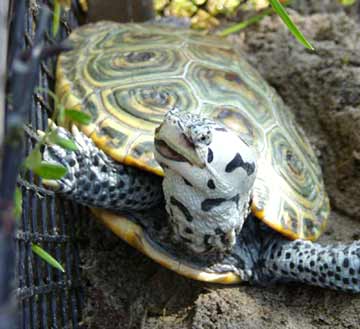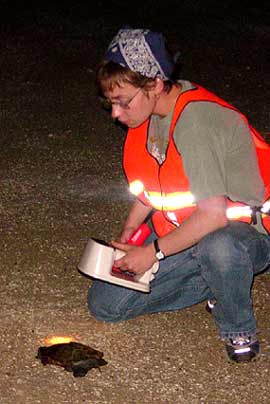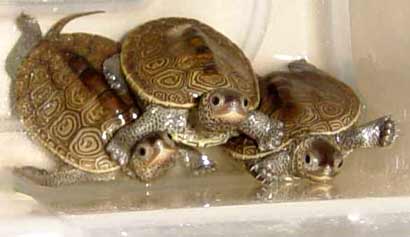|
A Letter Home from Turtle Camp

By Isadora Sageng
June 30, 2003 ó Everyone always promises to write, but most of those promised postcards seem to make it home a few days after the camper does, if ever. In my case, today is Day 29 of what I have been referring to as turtle camp, and this is the article that I promised to have
 |


Diamondback terrapin, Malaclemys terrapin
 |
|
 |
written over three weeks ago. The only difference is, this is not camp. I, along with seven other interns, am here at the Wetlands Institute to take part in an intense, ten-week project centering on New Jerseyís diamondback terrapin, Malaclemys terrapin. This summer is about research, conservation, and education, and the camp-like cramped camaraderie and frequent use of canoes is merely a coincidence. The fact is, I have never worked so hard or been so itchy in my life.
For the past three weeks, those of us on the Terrapin Project have been busy learning the tricks of the trade and preparing for the onset of the hectic terrapin nesting season. Normally, Stone Harbor would be under siege by now, but this year the cold weather has kept most of the terrapins in the water. They canít stay in there forever, though. With each passing day, more female terrapins are venturing out of the marsh to lay their eggs. Unfortunately, since most of their natural nesting grounds, the island barrier beaches, have been replaced by condominiums and parking lots, many terrapins are forced to look elsewhere. Hundreds of gravid females end up along the sandy embankments of the highways, crossing back and forth in search of the perfect spot, and getting crushed by passing cars.
Even though the weather has kept the usually biblical deluge of turtles down to a trickle, the roadkill count is still appallingly high. For a species as depreciated as the diamondback,
the combination of heavy traffic and determined turtles isn't just lethal to the individual terrapins; it could be lethal to the entire population. Sensational though it may sound, this is an annual catastrophe that affects the nesting females and the young almost exclusively, and you would be hard pressed to design a more deadly system.
I personally think that this is sufficient grounds for some sort of turtle superhero to move in and take over, but until then, itís up to us. Terrapin interns conduct round-the-clock road patrols, driving slowly up and down the streets, moving live turtles out of the way of traffic, and bringing injured ones back to the Institute for care. We also check the road-killed mothers for eggs, and harvest them if we can. That may sound depressing, if not downright gruesome, and if it doesnít, then I suppose my decision to be tasteful and not include a picture was a mistake. It is awful. My life-long fascination with reptiles is one of the biggest reasons that I came down here, and it is difficult to see so many of these already threatened creatures lining the streets in varying stages of pulverization.
 |


On a road patrol, Isadora logs a dead terrapin's microchip number using a PIT tag reader.
 |
|
 |
Someone asked me recently how I could stand doing something so sad (and sticky), and I told them it was all about memory. Sometimes it really is heartbreaking, frustrating, or disgusting enough to make me wonder why I took this internship, but I can always find plenty of reminders. Actually, there are at least four dozen of them in plastic tubs in a room across the hall from me, all waiting to be fed.



Hungry hatchlings wait for food.
 |
|
Last year, a total of 287 hatchlings were born from eggs recovered from road-killed mothers, and this year, the egg count is already up to 197. When this summerís hatchlings are released next year, they will have the larger bodies and harder shells that would take a terrapin in the wild two years to grow. They will also be implanted with a tiny microchip, which will allow us to identify them when and if they are recaptured or killed, and provide information on their movements, nesting and feeding habits, and survival rates.
|